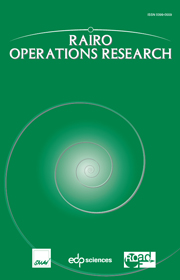Article contents
Genetic and Tabu search algorithmsfor peptide assembly problem
Published online by Cambridge University Press: 27 April 2010
Abstract
Determining amino acid sequences of protein molecules is one of the most important issues in molecular biology. These sequences determine protein structure and functionality. Unfortunately, direct biochemical methods for reading amino acid sequences can be used for reading short sequences only. This is the reason, which makes peptide assembly algorithms an important complement of these methods. In this paper, a genetic algorithm solving the problem of short amino acid sequence assembly is presented. The algorithm has been tested in computational experiment and compared with an existing tabu search method for the same problem. The results clearly show that the genetic algorithm outperformed the tabu search approach.
- Type
- Research Article
- Information
- Copyright
- © EDP Sciences, ROADEF, SMAI, 2010
References
- 2
- Cited by


